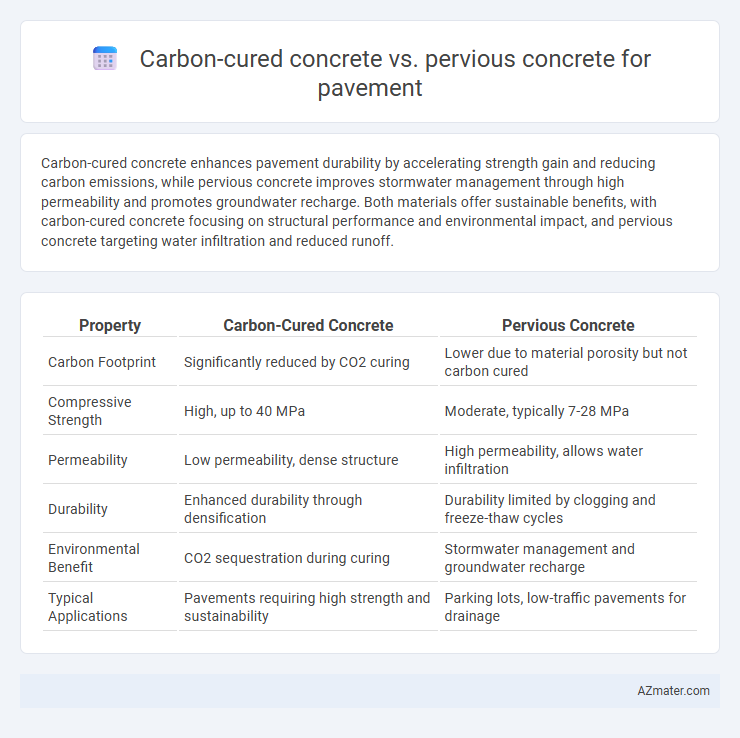Carbon-cured concrete enhances pavement durability by accelerating strength gain and reducing carbon emissions, while pervious concrete improves stormwater management through high permeability and promotes groundwater recharge. Both materials offer sustainable benefits, with carbon-cured concrete focusing on structural performance and environmental impact, and pervious concrete targeting water infiltration and reduced runoff.
Table of Comparison
| Property | Carbon-Cured Concrete | Pervious Concrete |
|---|---|---|
| Carbon Footprint | Significantly reduced by CO2 curing | Lower due to material porosity but not carbon cured |
| Compressive Strength | High, up to 40 MPa | Moderate, typically 7-28 MPa |
| Permeability | Low permeability, dense structure | High permeability, allows water infiltration |
| Durability | Enhanced durability through densification | Durability limited by clogging and freeze-thaw cycles |
| Environmental Benefit | CO2 sequestration during curing | Stormwater management and groundwater recharge |
| Typical Applications | Pavements requiring high strength and sustainability | Parking lots, low-traffic pavements for drainage |
Introduction to Innovative Concrete Technologies
Carbon-cured concrete enhances pavement durability by utilizing carbon dioxide to accelerate curing, resulting in reduced carbon footprint and improved strength. Pervious concrete offers superior stormwater management by allowing water infiltration through its porous structure, reducing runoff and promoting groundwater recharge. Both innovative technologies represent advances in sustainable pavement solutions, balancing environmental impact with functional performance.
Understanding Carbon-Cured Concrete
Carbon-cured concrete enhances durability by infusing carbon dioxide during the curing process, which accelerates strength gain and reduces porosity compared to traditional methods. This technology also contributes to carbon sequestration, capturing CO2 that would otherwise enter the atmosphere, making it an environmentally sustainable choice for pavement construction. Its improved compressive strength and reduced permeability offer long-lasting pavements with enhanced resistance to weathering and chemical exposure.
Exploring Pervious Concrete Characteristics
Pervious concrete for pavement features high porosity, allowing effective stormwater infiltration and reducing runoff, making it ideal for sustainable urban drainage systems. Its open-graded structure enhances groundwater recharge and mitigates surface water pollution by filtering contaminants. Compared to carbon-cured concrete, pervious concrete offers superior environmental benefits through improved water management and reduced heat island effect, while maintaining adequate structural strength for pedestrian and light vehicular loads.
Environmental Benefits: Carbon-Cured vs. Pervious
Carbon-cured concrete significantly reduces carbon emissions by capturing and storing CO2 during the curing process, contributing to lower overall greenhouse gas footprints in pavement construction. Pervious concrete enhances stormwater management by allowing water infiltration, reducing runoff and improving groundwater recharge, which benefits urban water cycles. Both materials promote sustainability: carbon-cured concrete targets climate impact mitigation, while pervious concrete focuses on addressing urban water management challenges.
Strength and Durability Comparison
Carbon-cured concrete demonstrates significantly higher compressive strength due to enhanced carbonation processes that accelerate cement hydration and densify the microstructure, resulting in improved durability against freeze-thaw cycles and chemical attacks. Pervious concrete, while offering superior permeability for stormwater management, typically exhibits lower strength and reduced durability under heavy traffic loads due to its porous structure and higher void content. The trade-off between strength and permeability highlights carbon-cured concrete as the preferred choice for pavement applications demanding long-term structural integrity and resistance to environmental degradation.
Water Management and Permeability
Carbon-cured concrete enhances durability and reduces carbon footprint but typically exhibits low permeability, limiting its effectiveness in water management for pavements. Pervious concrete is specifically designed to maximize water permeability, allowing efficient stormwater infiltration and reducing surface runoff. Selecting pervious concrete significantly improves groundwater recharge and mitigates urban flooding compared to carbon-cured concrete.
Cost Analysis and Lifecycle Economics
Carbon-cured concrete offers a higher initial material cost compared to traditional pervious concrete due to specialized carbonation equipment and processes. Lifecycle economics favor carbon-cured concrete by enhancing durability and reducing maintenance expenses over time, whereas pervious concrete provides cost savings through stormwater management benefits but may require more frequent repairs in freeze-thaw climates. Evaluating total cost of ownership, carbon-cured concrete's lower permeability and enhanced strength contribute to reduced long-term expenditures despite upfront cost differences.
Installation and Maintenance Considerations
Carbon-cured concrete requires specialized curing chambers that inject CO2 during the curing process, resulting in faster strength gain and reduced curing time compared to traditional methods. Pervious concrete installation demands precise mix design and careful placement to maintain its porous structure, ensuring effective stormwater infiltration and reducing runoff. Maintenance of carbon-cured concrete is minimal due to its enhanced durability and reduced permeability, while pervious concrete needs regular cleaning to prevent clogging and maintain permeability for optimal pavement performance.
Real-World Applications and Case Studies
Carbon-cured concrete improves CO2 sequestration and increases durability in pavement projects, demonstrated by its successful use in urban sidewalks and parking lots, such as in California's carbon capture pilot programs. Pervious concrete enhances stormwater management and reduces runoff, widely applied in parking areas and low-traffic roads, with case studies showing significant groundwater recharge benefits in states like Florida and New Jersey. Both materials contribute to sustainable pavement solutions but target different environmental challenges, with carbon-curing focusing on carbon footprint reduction and pervious concrete on hydrological performance.
Choosing the Right Concrete for Sustainable Pavements
Carbon-cured concrete offers enhanced durability and reduced carbon footprint by absorbing CO2 during curing, making it an innovative option for sustainable pavements. Pervious concrete improves stormwater management with its high permeability, reducing runoff and promoting groundwater recharge in urban areas. Selecting the right concrete involves balancing carbon sequestration benefits and hydrological performance to meet specific environmental and structural pavement requirements.

Infographic: Carbon-cured concrete vs Pervious concrete for Pavement
 azmater.com
azmater.com